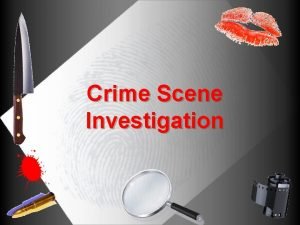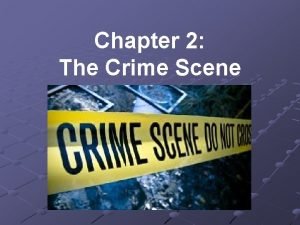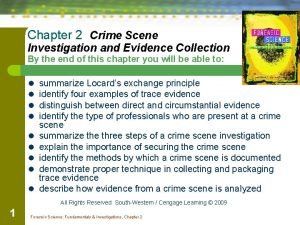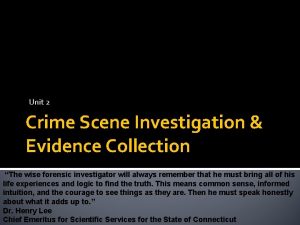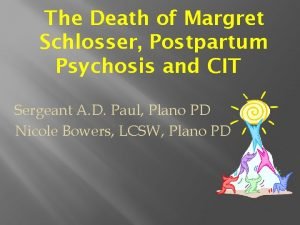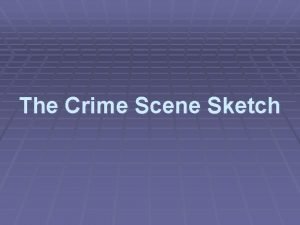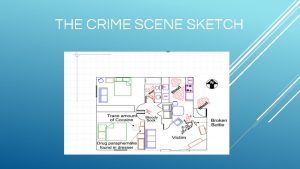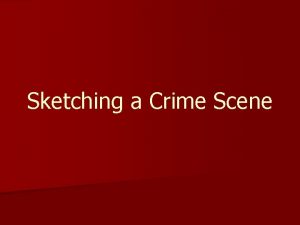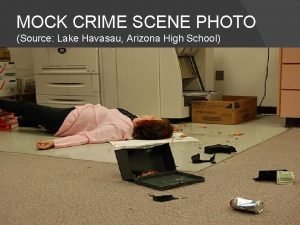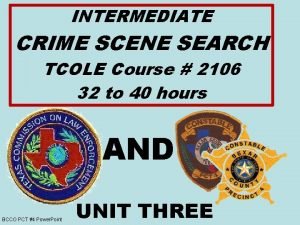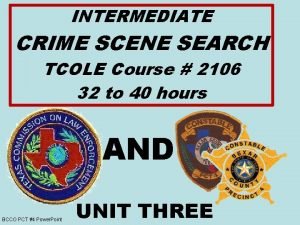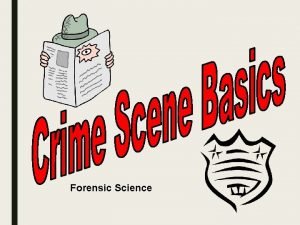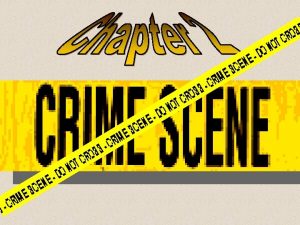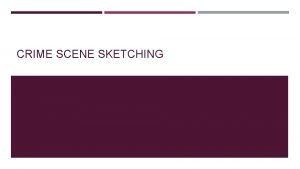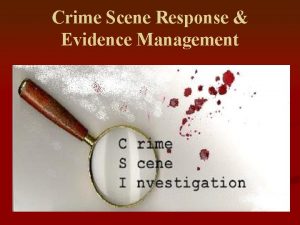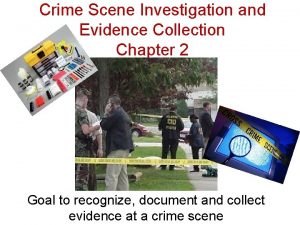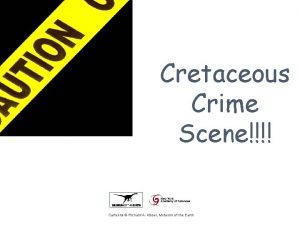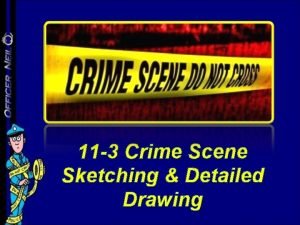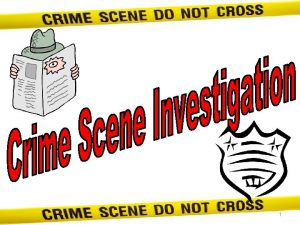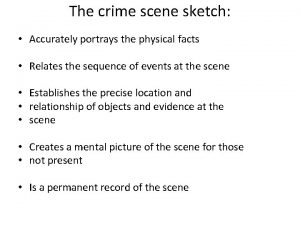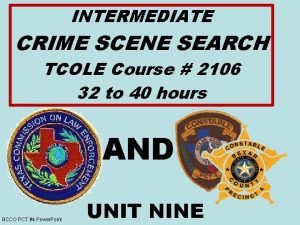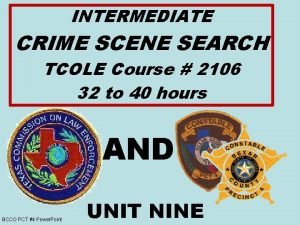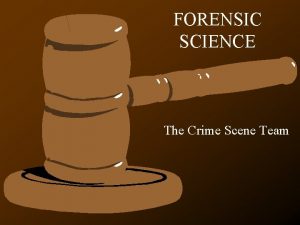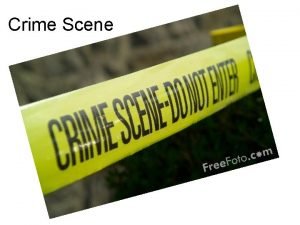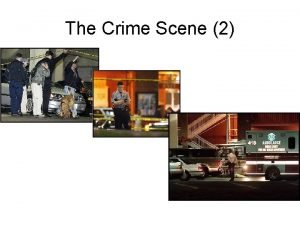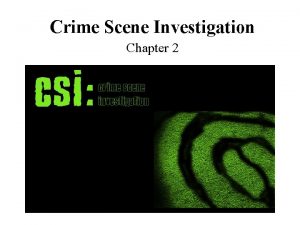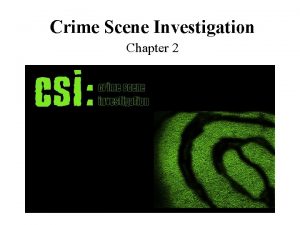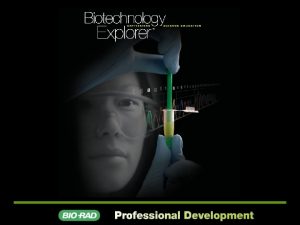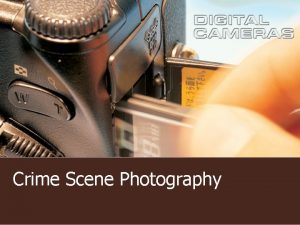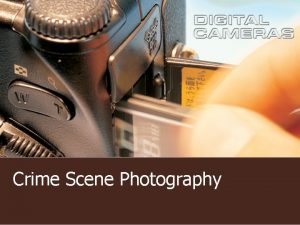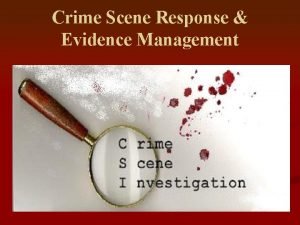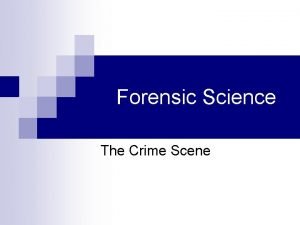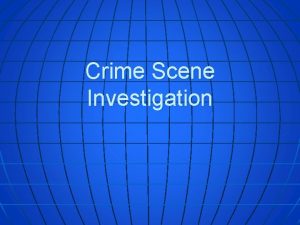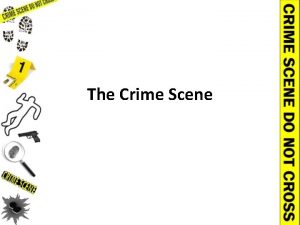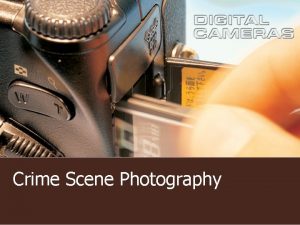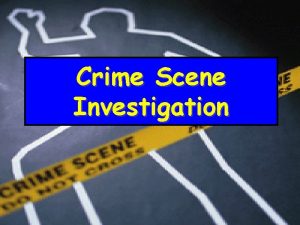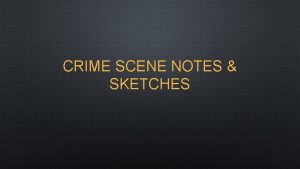Chapter 2 The Crime Scene First Steps First





































- Slides: 37

Chapter 2: The Crime Scene

First Steps First officer to arrive at scene is responsible for securing the crime scene. Assess Crime Scene for the Safety of the Officer Obtain medical assistance as needed Arrest the perpetrator Exclude all unauthorized personnel from crime scene Secure crime scene Begin preliminary exam of scene Recording the crime scene is critical to investigation.

Physical Evidence n n n Crime labs need physical evidence to “run. ” Physical evidence encompasses any and all objects that can establish a link between a crime and its victim or a crime and its perpetrator. Must be recognized at the crime scene.

The Beginning Forensic science begins at the crime scene. Recognize and preserve evidence or the most sophisticated lab instrumentation and technical expertise cannot salvage the investigation. Investigation techniques are not difficult to master. Within the bounds of comprehension of the average police officer.

Jon Benet Ramsey PART 1 http: //www. youtube. com/watch? v=cw 1 w 3 z. ZXe. Y

Recording Methods What are three methods used to record a crime scene? Which method is not always used? WHY?

Recording Methods Photography, sketches, and notes are three methods for crime-scene recording, Ideally, all three should be employed. Which method is not always used? WHY? Due to personnel and monetary restrictions, photography may not be utilized at every crime site.

Recording the Crime Scene What is the greatest obstacle investigators must overcome during crime scene processing and investigation? What challenges are faced by law enforcement and forensics specialists throughout this process?

Recording the Crime Scene Limited amount of time to work a crime scene in an untouched state. Opportunity to record the scene in this state must not be lost. Records will be useful during investigation. Required for presentation at trial. n Document condition of crime site and location of physical evidence. Every step of investigation must be documented thoroughly with an appropriate method.

Photography Most important prerequisite is for a crime scene to remain in an unaltered condition. Objects must not be moved until photographs have been taken from all necessary angles. n What is the exception to this guideline? As items of physical evidence are discovered, they are photographed to show their position and location relative to the entire scene.

Photography After overviews are taken, close-ups should be taken to record details of the object itself. A ruler or measuring scale is inserted near the object and included in the photo as a point of reference.

Photography – Digital Cameras can scan a scene and take dozens of photos Data used to create 3 -D models n n n Scene in full color Viewed from any vantage point Measure, analyze, courtroom

Video Recording More popular due to decreasing costs of technology and equipment. Offers a more efficient method for documenting the entire crime scene and immediate surrounding area.

Video Recording guidelines Guidelines for recording a crime scene. 1. Brief introduction by investigator n Date, Time, Location, Type of crime, other information 2. Video tape crime scene without audio 3. Wide angle and close-up views showing locations of all evidence 4. Slow camera movements – panning/zooming

Notes Note taking is a constant activity throughout the processing of a crime scene. Must include a detailed written description of the scene documenting the locations of all items of physical evidence recovered. n n Time item was discovered By whom it was discovered How and by whom it was packaged and marked Disposition of item after it was collected This record may be the only source of information for refreshing one’s memory.

SEARCH PATTERNS Depends on the locale and size of the area. Actions of suspects and victims at the scene. Best to have one person supervise the search and collection of evidence. Without proper supervision, searches can be n n n Confusing Waste of time and resources (manpower/money) Counterproductive

Search Patterns Page 38 Strip or Line Search - One or two investigators n Boundaries important or evidence can be missed Grid Search - Two investigators n Very thorough but requires set boundaries Spiral Search - One person n n Inward or Outward Spiral can easily find footprints Precision required to find all evidence Wheel / Ray / Pie Search - Multiple persons n Not preferred – difficult to search all areas Quadrant or Zone Search - Multiple persons in teams n n Best for large areas Includes all points of entry and exit by criminals

Search Patterns

Sketches Once photographs are taken, the crime-scene investigator will sketch the scene. Rough Sketch – A draft representation of all essential information and measurements at a crime scene. Drawn at the crime scene, it shows all recovered items of physical evidence as well as other important features of the crime scene. Finished Sketch – A precise rendering of the crime scene, usually drawn to scale. This type is normally not completed at the crime scene.

Video Case Study Part II http: //www. youtube. com/watch? v=DJn. TEb Cd. QTQ Jon. Benet Ramsay Investigation PART II Complete the Question Set as you watch the video clip.

Jon Benet Ramsay Investigation PART III http: //www. youtube. com/watch? v=ag 9 Df. F ESgb. Y

Sketches Unlike a rough sketch, the finished sketch is drawn with care and concern for aesthetic appearance.

Crime Scene Sketching Create a ROUGH Sketch of the classroom. Include all of the identifiable objects. Floors and Walls Provide measurements of all items and fixtures. The Crime Scene is drawn from a top down perspective.

Locating Physical Evidence Circumstances of a crime will dictate type of evidence to be searched for n n General knowledge Experience gained from multiple investigations Homicide – Weapon and Cross-transfer of evidence such as hair, fibers, and blood Burglary - Point of entry and individual evidence Vehicle searches – Inside, outside, and undercarriage

Collecting and Packaging Some evidence can only be found through careful examination and analysis n Clothing items wrapped separately n Crime scene areas vacuumed analyzed n n Sweepings from different areas packaged individually Individual fingernail scrapings also examined

Collecting Evidence from a Body Search continues in the autopsy room Tissues and organs Items sent to forensic laboratory n n n n Clothing Fingernail scrapings Head and pubic hairs Blood Body fluids and tissue samples (sex-related crimes) Recovered bullets and casings Hand swabs for gunshot residue

Handling Evidence Cannot be moved until properly recorded. Handle and process to prevent any change in evidence n n n Contamination or damage Improper/careless packaging Original collected state – blood on a knife

Packaging Evidence Requires a large assortment of packaging materials and tools. n n n Forceps Pill bottles – hair, glass, fibers Manila envelopes and Screw top vials – trace evidence Sealable plastic bags – clothing Airtight containers – charred debris Druggist fold – fine powders Separate different items from different locations Prevents cross-contamination and damage by contact

Druggist Fold or Paper Bindle

Jon Benet Ramsay Case Study PART IV http: //www. youtube. com/watch? v=Qof. H 2 g Bt. C 6 A

Jon Benet Ramsay Case Study PART V https: //www. youtube. com/watch? v=Cx. DM JUDg. Pkw

Biological Materials and DNA Use disposable tools Air dry all items Minimize personal contact n n Fluids considered infectious Gloves, face masks, and shoe covers Wrapping paper, manila envelopes, paper bags n Sealed containers accumulate moisture and mold growth

DNA Polymerase Chain Reaction – technique used to amplify minute traces of DNA for analysis All objects involving cross-transfer n n n Stamps/envelopes Chewing gum Sweatband of a hat

Submitting Evidence Standard/Reference Sample – Physical evidence whose origin is known that can be compared to crime scene evidence. n Hair, Blood, Automobile Paint Buccal Swab – swab of inner portion of cheek DNA Used for DNA Profiling Substrate Control – material used in comparison during a fire/accelerant (gasoline)

Crime Scene Safety Increasing spread of AIDS and Hepatitis B Transmitted through n n n Exchange of body fluids – blood, semen, vaginal secretions Intravenous drug needles and syringes Transfusion of infected blood, tissues, organs

Crime Scene Safety Guidelines OSHA requires Hep B vaccinations 1. Two pairs of latex gloves, shoe covers, coveralls 2. Respirator mask, goggles, face shield 3. Be alert to sharp objects 4. Use red Biohazard bags for dangerous items 5. Eating, smoking, drinking, application of makeup is prohibited 6. Disinfect exposed area of body and discard all used protective gear

Illegal Search and Seizure Justification of a warrantless search 1. Emergency circumstances 2. prevent immediate loss/destruction of evidence 3. Search made by consent of parties involved
 What are the 5 steps in crime scene investigation
What are the 5 steps in crime scene investigation Druggist fold steps
Druggist fold steps Locard exchange principle
Locard exchange principle The west memphis three crime scene photos
The west memphis three crime scene photos What are the seven s's of crime scene investigation
What are the seven s's of crime scene investigation Types of crime scene
Types of crime scene Margret schlosser
Margret schlosser Forensic science learning targets
Forensic science learning targets Baseline crime scene sketch
Baseline crime scene sketch Exploded sketch or cross projection sketch
Exploded sketch or cross projection sketch Crime scene factoring and quadratic functions answer key
Crime scene factoring and quadratic functions answer key Sketching a crime scene
Sketching a crime scene Scene plan
Scene plan 2106 crime scene investigation
2106 crime scene investigation 2106 crime scene investigation
2106 crime scene investigation Crime scene factoring and quadratic functions answer key
Crime scene factoring and quadratic functions answer key Crime scene vocabulary
Crime scene vocabulary Forensic science begins
Forensic science begins Cross-projection sketch
Cross-projection sketch Crime scene photography management
Crime scene photography management While the csi team is searching the crime scene, _____.
While the csi team is searching the crime scene, _____. Crime scene vocabulary
Crime scene vocabulary Cretaceous crime scene
Cretaceous crime scene What should a crime scene sketch include
What should a crime scene sketch include The term encompasses all objects
The term encompasses all objects A crime scene sketch should include
A crime scene sketch should include Spiral search method example
Spiral search method example Crime scene storyboard
Crime scene storyboard Robert pickton trailer
Robert pickton trailer Tcole 2106
Tcole 2106 2106 crime scene investigation
2106 crime scene investigation Crime scence investigator
Crime scence investigator Crime scene reconstruction definition
Crime scene reconstruction definition _____ is done with the first responding officer.
_____ is done with the first responding officer. Crime scene investigation background
Crime scene investigation background Crime scene 2
Crime scene 2 Crime scene inference
Crime scene inference Clay lawson and russell odom
Clay lawson and russell odom
